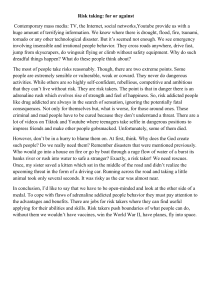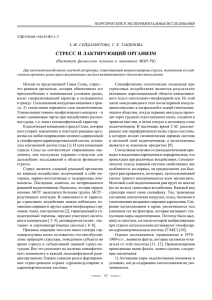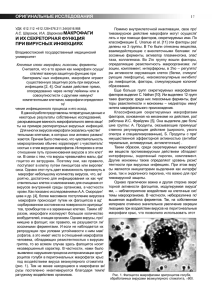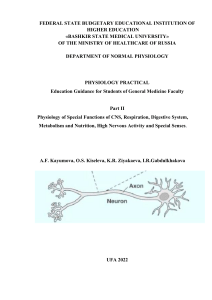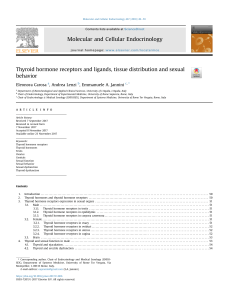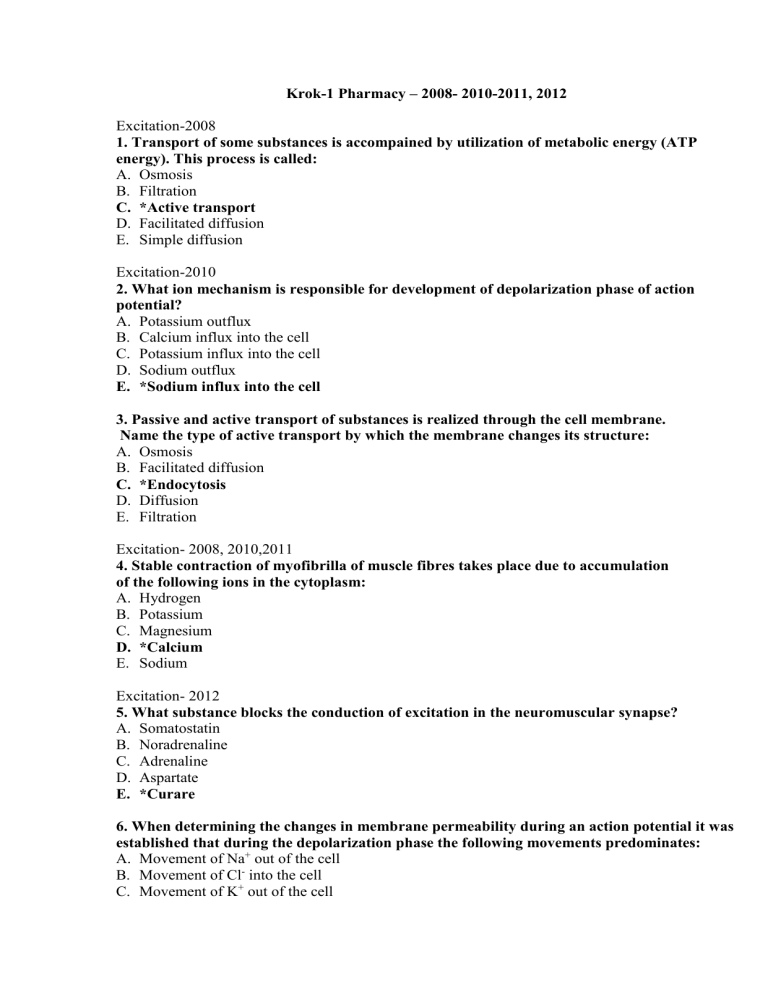
Krok-1 Pharmacy – 2008- 2010-2011, 2012 Excitation-2008 1. Transport of some substances is accompained by utilization of metabolic energy (ATP energy). This process is called: A. Osmosis B. Filtration C. *Active transport D. Facilitated diffusion E. Simple diffusion Excitation-2010 2. What ion mechanism is responsible for development of depolarization phase of action potential? A. Potassium outflux B. Calcium influx into the cell C. Potassium influx into the cell D. Sodium outflux E. *Sodium influx into the cell 3. Passive and active transport of substances is realized through the cell membrane. Name the type of active transport by which the membrane changes its structure: A. Osmosis B. Facilitated diffusion C. *Endocytosis D. Diffusion E. Filtration Excitation- 2008, 2010,2011 4. Stable contraction of myofibrilla of muscle fibres takes place due to accumulation of the following ions in the cytoplasm: A. Hydrogen B. Potassium C. Magnesium D. *Calcium E. Sodium Excitation- 2012 5. What substance blocks the conduction of excitation in the neuromuscular synapse? A. Somatostatin B. Noradrenaline C. Adrenaline D. Aspartate E. *Curare 6. When determining the changes in membrane permeability during an action potential it was established that during the depolarization phase the following movements predominates: A. Movement of Na+ out of the cell B. Movement of Cl- into the cell C. Movement of K+ out of the cell D. Movement of K+ into the cell E. *Movement of Na+ into the cell СNS-2008 1. Name inhibitory transmitters: A. Acetylcholine and DABA B. Serotonine and glycin C. Noradrenaline and dopamine D. *GABA and glycin E. Adrenaline and noradrenaline CNS-2008, 2010 2. During preventive examination of a patient a doctor revealed considerable weakening of patellar-tendon reflex. What part of CNS might be affected? A. Metencepdalon B. Cerebellum C. Thalamencephalon D. Mesencephalon E. *Spinal cord 3. What mediator provides information transmission from nerve termination of motoneurons to the fibres of skeletal muscles? A. GABA B. *Acetylcholine C. Adrenaline D. Serotonin E. Noradrenaline CNS-2010 4. To relax skeletal muscles during complex surgeries, curarelike substances are applied. These substances block the following structures: A. Synaptic structures of the spinal cord B. Red nuclei of the mesencephalon C. Basal ganglion D. *Neuromuscular synapses E. Vegetative ganglions CNS-2010, 2011 5. A man got an injection of curarelike substance causing the relaxation of all skeletal muscles. What is its mechanism of action? A. Block of Ca2+- channels of presynaptic membrane B. Disturbance of cholinesterase synthesis C. Disturbance of acetylcholine synthesis D. *Block of cholinergic receptors of postsynaptic membrane E. Disturbance of acetylcholine secretion CNS – 2011 6. Drugs that block certain channels can prevent the transmission of excitation from presynaptic membrane to the postsynaptic membrane of synapse. What channels are blocked? A. *Sodium B. Calcium C. Potassium ATP-dependant D. Chlorine E. Potassium potential-dependent 7. Which of these chemical substances CANNOT act as an excitatory neurotransmitter in the central nervous system? A. Noradrenaline B. Serotonine C. Substance P D. Dopamine E. *Glycine CNS-2011. Cardiac 8. In order to reduce heart rate during tachycardia alternative medicine doctors recommend to induce artificial vomiting. Specify the efferent nerve of this reflex: A. Phrenic nerve B. Sympathetic (abdominal) nerve C. Glossopharyngeal nerve D. Hypoglossus E. *Vagus СNS-2012 9. In order to increase the inhibitory processes in the CNS the pharmacological agents are used that cause the following process on the postsynaptic membranes: A. Depolarization B. Afterdepolarization C. Activation of calcium channels D. Activation of sodium channels E. *Hyperpolarization 10. While performing finger-nose test the examinee could not touch the tip of his nose with his fingertip having his eyes closed. What structure of the central nervous system is damaged? A. Thalamus B. Cortex C. *Cerebellum D. Spinal cord E. Quadrigeminal plate Endocr-2008 1. Preventive examination of a woman revealed enlargement of her thyroid gland, exophthalmos, high body temperature, increase of heart rate up to 110 times per minute. It is advisable to determine content of the following hormone in blood. A. Insulin B. Cortisol C. Adrenaline D. *Thyroxine E. Noradrenaline 2. Introduction of a hormone into a man’s organism resulted in increased water reabsorption in kidneys, high vascular tone, rise of arterial pressure. What hormone was introduced? A. Noradrenaline B. Aldosterone C. *Vasopressin D. Thyroxine E. Adrenaline 3. As a result of reduced water reabsorption in nephron tubules daily diuresis of a patient has increased up to 10 litres. This might be caused by reduced secretion of the following hormone: A. Parathormone B. *Vasopressin C. Insulin D. Aldosterone E. Thyrocalcitonin Endocrine, 2008, 2011 4. A woman in labour was given a preparation that activates contractions of smooth uterine muscles. What hormone is contained in this preparation? A. Angiotensin B. Secretin C. *Oxytocin D. Bradykinine E. Gastrin 5. A boy of 4 year old. Glucose concentration in blood plasma is 12 millimole/l. This might be caused by deficiency of the following hormone: A. Adrenocorticotropin B. Cortisol C. Somatotropin D. *Insulin E. Glucagon 6. What disorders are possible as a result of thyroid insufficiency during infancy? A. Nanism B. Basedow’s disease C. *Cretinism D. Itsenko-Cushing syndrome E. Gigantism Endocrine- 2008, 2010 8. A patient has bradycardia, moderate hypotension, decrease of basal metabolism, edemata. What abnormality can induce such syndrome? A. Parathyroid hypofunction B. Adrenal hypofunction C. Parathyroid hyperfunction D. *Thyroid hypofunction E. Thyroid hyperfunction 9. Anxious condition can be characterized by reduced salivation and sense of dry mouth. What mediator is exuded out of nerve terminals innervating salivary glands? A. Histamine B. Serotonin C. Acetylcholine D. GABA E. *Noradrenaline 10. Introduction of glucocorticoids induces strengthening of glucose concentration in blood. Which of the following processes will be activated in liver? A. *Gluconeogenesis B. Glycogenolysis C. Glycolysis D. Ketogenesis E. Oxidation of fatty acids Endocrine – 2010,2012 11. Early pregnancy test involves analysis of a woman’s urine. Pregnancy is ascertained by presence of the following hormone: A. Aldosterone B. Estriol C. Testosterone D. *Chorionic gonadotropin E. Progesterone 12. The thyroid gland synthesizes a hormone that lowers the rate of Ca2+ concentration in blood thus facilitating its deposition in bones. What hormone is it? A. *Calcitonine B. Triiodthyronine C. Parathormone D. Adrenaline E. Thyroxine Endocrine- 2011 13. Parents of a 11-year-old boy noticed that he is far behind his peers in the physical development. After the X-ray an endocrinologist revealed that the growth zones of tubular bones had already closed. Under these conditions, the intake of growth hormone can result in the development of: A. Dwarfism B. Gigantism C. *Acromegaly D. Myxedema E. Cretinism 14. Which of the following presentations can be explained by the functional effects of adrenaline? A. B. C. D. E. Dilatation of the skin vessels Decrease in heart rate High uropoiesis *Relaxation of bronchial muscles Intensification of stomach and intestines contraction 15. Alpha cells of pancreas stimulate synthesis of the glucagon hormone that is involved into the carbohydrate metabolism. It has the following effect on liver processes: A. *Activates glycogenolysis B. Activates alcocholic fermentation C. Inhibits glycolysis D. Activates lypogenesis E. Inhibits glycogenolysis Endocrine –2012 16. After an insulin injection a 45 year-old woman with a long history of diabetes mellitus has developed weakness, paleness, palpitation, anxiety, double vision, numbness of lips and the tip of tongue. Blood glucose is at the rate of 2,5 mmol/l. What complication has developed in the patient? A. *Hypoglycemic coma B. Hyperketonic coma C. Uremic coma D. Hyperosmolar coma E. Hyperglycemic coma 17. Food rich in carbohydrates at first increases the blood glucose and then decreases its rate due to the insulin action. What process is activated by this hormone? A. Breakdown of proteins B. Breakdown of glycogen C. Breakdown of lipids D. Gluconeogenesis E. *Synthesis of glycogen Blood-2008 1. What disease of blood coagulation system is based upon abrupt deceleration of blood coagulation due to disturbed formation of plasma thromboplastin (VIII factor deficit)? A. Symptomatic thrombocytopenia B. Hemorrhagic purpura C. *Hemophilia D. Thrombocytopenic purpura E. Hemorrhagic vasculitis 2. In order to restore a man’s circulating blood volume he was transfused with blood substitute – isotonic solution NaCl. What is the concentration of this solution? A. 0,5% B. 1% C. 3% D. *0,9% E. 0,3% 3. Solution applied as isotonic solution should have the following osmotic pressure: A. *700-800kPa B. 900-1000kPa C. 500-600kPa D. 200-300kPa E. 300-400kPa 4. A. B. C. D. E. First leukocytes that appear in the inflammation focus are: Eosinophils Lymphocytes *Neutrophils Basophils Monocytes 5. A 40 year old woman has been suffering from profuse uterine bleeding for a long time. Blood count: Hb – 90 g/l, erythrocytes – 3,9x1012/l, colour index – 0,6. What is the main cause of hypocromic anemia? A. Deficiency of vitamin B12 B. *Iron loss with blood C. Nonassimilibity of iron D. Increased consumption of iron E. Insufficient iron content in food ration Blood – 2010 6. What is the osmotic pressure of medicinal solutions used as blood isotonics? A. 420-448 kPa B. *740-789 kPa C. 900-960 kPa D. 690-720 kPa E. 600-670 kPa 7. A patient with acute pneumonia has an edema and hardening of pulmonary tissue. What cells are the first to infiltrate the inflammation zone and provide the effective protection from the bacterial infection? A. Thrombocytes B. Eosinophils C. Monocytes D. Basophils E. *Neutrophils 8. A patient diagnosed with acute abdomen was delivered to the hospital. A doctor suspected acute appendicitis and ordered urgent blood test. What factor would be the evidence of acute inflammation in this patient? A. *Leukocytosis B. Eosinophilia C. Leukopenia D. Erythrocytosis E. Erythropenia Blood-2011 9. A child with evident hypotrophy got edemata on his lower extremities, ascites. What is the main mechanism of pathogenesis of cachectic edema? A. Disturbance of lymph outflow B. Increased permeability of vascular wall C. Rise of hydrostatic blood pressure D. *Drop of oncotic pressure of blood plasma E. Rise of oncotic pressure of intercellular fluid 10. Humoral immune response to an antigen results in generation of antibodies produced by plasmocytes arisw as a result of immunostimulated division from the following cells of immune system: A. T-killers B. *B-lymphocytes C. Monocytes D. Granulocytes E. T-helpers Blood –2012 11. Clinical practice involves measurement of ESR. What are the components of blood plasma that mainly determine the ESR value? A. Urea B. Inorganic ions C. *Globulins D. Phospholipids E. Bilirubin 12. A continuous stay in mountains causes an increase of blood oxygen capacity. What is the possible reason for this phenomenon? A. Decrease in respiratory rate and depth B. Increase of PO2 in the air C. Development of gas acidosis D. *Development of functional erythrocytosis E. Increase of PCO2 rate in the air Respir- 2008 1. What factors of humoral regulation stimulate the function of the respiratory centre the most actively? A. Adrenaline B. Thyroxine C. *Carbon dioxide D. Insulin E. Acetylcholine 2. A premises has high content of carbonic gas. A man who entered this premises would experience the following changes of his respiration (depth and rate): A. Respiration would stay unchanged B. *Increased respiration rate and depth C. Increased respiration rate and decreased respiration depth D. Decreased respiration rate and increased depth E. Decreased respiration rate and depth 3. Erythrocytes contain carbonic acid produced from CO2 and H2O. What enzyme ensures synthesis of carbonic acid in erythrocytes and its decomposition in pulmonary capillaries? A. Lipase B. Amylase C. *Carbonic anhydrase D. Alcaline phosphate E. Elastase 4. A patient took maximally deep breath. Air volume being in lungs under these conditions is called: A. Residual volume B. *Total lung capacity C. Vital lung capacity D. Inspiratory reserve volume E. Tidal volume Respiration-2010, 2011 5. Before diving experienced divers first take several deep breaths. They do it in order to: A. *Remove as much as possible CO2 B. Increase respiratory volume (RV) C. Reduce functional residual capacity of lungs D. Increase total lung capacity (TLC) E. Increase lung vital capacity (LVC) Respiration-2011 6. A healthy 45-year-old man is sitting in a chair reading a newspaper. What muscles ensure breathing in a sitting position? A. Scalenes B. *Diaphragm and external intercostal muscles C. Internal intercostal muscles and straight muscles of abdominal wall D. Diaphragm and internal intercostal muscles E. Sternocleidomastoid muscles Respiration – 2012 7. The volume of air exhaled by a healthy person during quite breathing was measured with a spirometer, it was 0,5 liter. What is this volume called? A. Expiratory reserve volume B. Inspiratory reserve volume C. Vital capacity of lungs D. *Tidal volume E. Residual volume Heart-2008 1. In course of an experiment a branch of vagus that innervates the heart is being stimulated. What changes of heart activity will appear in the first place? A. Heart force fall B. Increase of heart force C. Increase of heart rate D. *Heart rate fall E. Rise of arterial pressure 2. What changes will be observed in the isolated heart after introduction of adrenaline into perfusion solution? A. Conduction reduction B. *Heart rate rise C. Excitability reduction D. Heart rate fall E. Heart force fall Heart-2008, 2011 3. It is required to diminish pump function of patient’s heart. This can be done by means of blockers of the following membrane cytoreceptors: A. *β– adrenoreceptors B. Dopamine receptors C. Muscarinic receptors D. Nicotinic cholinoreceptors E. α- adrenoreceptors Heart- 2008, 2011 4. A patient takes blocker of muscarinic cholinoreceptors of parasympathetic nerve organ synapses. What changes of heart activity will be observed? A. Prolongation of atrioventricular delay B. Heart rate and heart force fall C. Heart force fall D. *Heart rate rise E. Heart rate fall Heart – 2010 5. Heart automatism is possible due to the atypical cardiomyocytes forming the cardiac conduction system. What part of this system is the primary cardiac pacemaker? A. His’ bundle branches B. Purkinje’s fibers C. *Sinoatrial node D. Atrioventricular node E. His’ bundle 6. Study of an isolated heart shows that it keeps on contracting even after removal from the body. This effect owers to the following pecularity of the myocardium: A. Contractility B. Excitability C. Conductivity D. *Automatism E. Adiaphoria Heart 2010,2011 7. During the practical training the students placed the isolated frog’s heart into a solution. This caused the cardiac arrest in diastole. What solution was the heart placed into? A. 1% solution of CaCl2 B. C. D. E. *3% solution of KCl 3% solution of NaCl 0,1% solution of MgCl2 1% solution of NaCl 8. In course of an experiment the experimenters are stimulating a sympathetic nerve responsible for heart innervation. What changes of cardiac activity can be expected? A. Decrease in heart rate B. Increase in heart rate C. Decrease in heart force D. *Increase in heart rate and force E. Deceleration of excitement conduction Heart –2012 9. A man who had been struck in the epigastric region had a heart arrest. What caused such changes in the cardiac activity A. Increased sympathetic tonus B. Angiotensin II release C. Histamine release D. Adrenaline release E. *Increased vagal tone 10. Heart rate of a person at rest is 40/min. What structure is the pacemaker of heart in this man? A. His’ bundle B. Sinoatrial node C. *Atrioventricular node D. Purkinje fibers E. His’ bundle branches 11. What wave of ECG characterizes the spread of excitation throughout the heart atria? A. S B. T C. Q D. R E. *P 12. Cardiac tones are the outer manifestations of heart functioning. What is the cause of the II tone? A. *Closure of semilunar valves B. Vibration of the vintricle walls C. Closure of cuspid valves D. Chest movements E. Vibration of the atrium walls Haemodynamics-2008 1. What vessels have the minimal linear velocity of sanguimotion (blood movement)? A. Large arteries B. Arterioles C. Aorta D. Veins E. *Capillaries 2. A child with evident hypotrophy got edemata on his lower extremites, ascites. What is the main mechanism of cachetic edema? A. *Drop of oncotic pressure of blood plasma B. Rise of hydrostatic blood pressure C. Disturbance of lymph outflow D. Rise of oncotic pressure of intercellular fluid E. Increased permeability of vascular wall 3. A 58 year old patient complained about persistent rise of arterial pressure. Clinical examination revealed chronic renal disease accompained by disturbance of renal blood flow. Rise of arterial pressure was induced by activation of the following regulatory system: A. Sympathoadrenal B. Sympathetic nervous C. Parasympathetic nervous D. Hypothalamo-pitutary-adrenal E. *Renin-angiotensin 4. During an exam a student got high arterial pressure and palpitation. What is the probable cause of this phenomenon? A. Decreased tonus of parasympathetic nervous system B. *Increased tonus of sympathetic nervous system C. Low excitability threshold of α and β adrenoreceptors D. Secretion of glucocorticoids E. Increased volume of circulating blood Haemodynamics- 2010 5. A child with evident hypotrophy got edemata on his lower extremites, ascites. What is the main mechanism of cachetic edema? A. Disturbance of lymph outflow B. Rise of hydrostatic blood pressure C. Rise of oncotic pressure of intercellular fluid D. *Drop of oncotic pressure of blood plasma E. Increased permeability of vascular wall Haemodynamic -2011 6. After a 40-year-old patient had changed his body position from vertical to horizontal one his heart rate dropped from 70 to 65 bpm. This reaction was caused by the following reflex: A. Bainbridge reflex B. Goltz reflex C. Aschner reflex D. Pressor reflex E. *Depressor reflex Haemodynamics- 2012 7. A hospital admitted a patient with arterial hupertension induced by renal artery stenosis, complaints of persistent nausea and headache. The main element in the pathogenesis of hypertension is thw activation of the following system: A. Parasympathetic B. *Renin-angiotensin C. Kallikrein-kinin D. Sympathoadrenal E. Hypothalamic-pitutary Digest-2008 1. When a man is excited his salivation is reduced, there is sensation of dry mouth. What mediator is excreted from nerve endings that innervate salivary glands? A. Serotonin B. Histamine C. Acetylcholine D. GABA E. *Noradrenalin 2. 150 ml of meat broth was introduced into the gastric cavity of an experimental dog through the feeding tube. This will result in rapid rise of concentration of the following hormone in the animal’s blood A. Neurotensin B. Vasointestinal polypeptide C. Insulin D. *Gastrin E. Somatostatin Digest-2008, 2011 3. Gastric juice of a patient has decreased concentration of enzymes. What secretory cells of stomach display disfunction? A. Cells of tegumental epithelium B. *Chief cells of glands C. G-cells D. Parietal cells of glands E. Glands mucocytes 4. When fats get into an organism they are digested and absorbed. What products of fat hydrolysis are absorbed in an intestine? A. *Glycerine, fatty acids B. Monosaccharides C. Lipoproteids D. Polypeptides E. Amino acids Digestion-2010, 2011 5. Digestion of proteins in the digestive tract is a complex process of their hydrolysis till peptides and free amino acids. What enzymes decompose proteins in the duodenum? A. Lipase, phospholipase B. *Trypsin, chemotrypsin C. Pepsin, gastricsin D. Enterokinase, lipase E. Amylase, maltase 6. Fatty food is digested by means of several digestive juices. Which of them enables fat emulsification? A. Pancreatic juice B. *Bile C. Saliva D. Intestinal juice E. Gastric juice 7. A. B. C. D. E. What segment of digestive tract secretes digestive juice that has acid reaction? Large intestine Oral cavity *Stomach Small intestine Esophagus Digestion-2008, 2011 8. A patient was prescribed a bile preparation for better digestion of fatty food. What components of this preparation cause fat emulsification? A. *Bile acids B. Bile pigments C. Diglycerides D. Cholesterol and its ethers E. Bilirubinglucuronids Digestion-2008,2010, 2011 9. It is known that digestion of proteins, fats and carbohydrates happens due to proteases, lipases and amylases respectively. What digestive juice contains all three enzyme groups enough for digestion? A. Bile B. Juice of large intestine C. *Juice of pancreas D. Saliva E. Gastric juice 10. Roentgenological examination of a patient revealed delayed transition of contrast material from the stomach to the duodenum. It is caused by disturbance of the following function of digestive tract: A. *Evacuatory function of stomach B. Water absorbtion C. Membrane digestion D. Protein digestion E. Secretory function 11. Bile contains of bile acids. Choose one of them. A. Arachidonic B. Pyruvic acid C. Glutamine D. Lactic E. *Cholic 12. A patient was diagnised anacydic gastritis. What enzyme activity will be reduced? A. Trypsin B. Chemotrypsin C. *Pepsin D. Amylase E. Lipase 13. A patient was prescribed with bile preparation for the purpose of improvement of fatty food digestion. What components of this preparation take part in fat emulsification? A. Cholesterol and its ethers B. Digliceride C. Higher fatty acids D. Bilirubin-glucuronids E. *Bile acids Digestion – 2010 14. Ligation of the common bile duct in an experimental animal results in block of bile inflow to the duodenum. His will cause the failure of hydrolysis of the following substances: A. Carbohydrates B. Proteins and carbohydrates C. Proteins D. Fats and carbohydrates E. *Fats Digestion- 2010, 2011 15. It is required to increase the secretion of gastric juice in an experimental dog with stomach fistula. What should be introduced into the stomach? A. White bread B. *Meat broth C. Sour cream D. Milk E. Dreid bread Digestion- 2011 16. Protein digestion in the stomach is carried uot by pepsin secreted in form of an inactive pepsinogen. Pepsinogen is converted to pepsin by the removal of the N-terminal peptide that is provoked by: A. Bile acid B. Acetic acid C. Amino acids D. *Perchloric acid E. Sulfuric acid 17. Study of secretory function of stomach revealed a decrease in hydrochloric acid concentration in gastric juice. This must cause hypoactivity of the following enzyme: A Lipase B. Amylase C. Dipeptidase D. Hexokinase E.* Pepsin 18. One of saliva functions is the bactericidial one. It can be fulfilled due to the following substance: A. Mucin B. Bradykinin C. Amylase D. Maltase E. *Lysozyme Digestion –2012 19. Proteolytic enzymes of gastric juice exhibit maximum activity in the medium with the following pH: A. pH 7.0 B. pH 9,0 C. pH 6,5 D. pH 0,5-1,0 E. *pH 3,2-3,5 20. Which of the listed biologically active compounds inhibits the secretion of pancreatic juice? A. *Atropine B. Secretin C. Insulin D. Gastrin E. Acetylcholine 21. When chime enters the duodenum, it stimulates the secretion of gastrointestinal hormones. Which hormone is responsible for release of enzymes included in digestive juices? A. Secretine B. Glucagon C. Somatostatin D. Calcitonin E. *Cholecystokinin-pancreozymin Kidneys-2008, 2012 1. Analysis of urine composition revealed changed concentration of sodium ions. Which of hormones provides regulation of sodium ions reabsorption in nephron canaliculi? A. Adrenaline B. Vasopressin C. *Aldosterone D. Somatostatin E. Parathormone 2. Final urine is generated as a result of three sequential processes. Name the most credible sequence: A. Reabsorption, filtration, secretion B. Secretion, reabsorption, filtration C. Secretion, filtration, reabsorption D. *Filtration, reabsorption, secretion Kidneys-2008, 2011 3. Production of primary urine in kidneys is induced by filtration in renal corpuscles. What components of blood plasma are absent in the primary urine? A. Ions B. Urea C. Amino acids D. Glucose E. *Proteins 4. A female patient suffers from chronic glomerulonephritis. Urine analysis revealed proteinuria, hematuria, leukocyturia. Propeinuria indicates disturbance of the following process in kidneys: A. Renal blood flow B. Tubular reabsorption C. Tubular secretion D. Tubular secretion and reabsorption E. *Glomerular filtration Kidneys- 2010 5. Nephron is the structural and functional unit of the kidneys. The process of filtration takes place in the following part of it: A. Distal tubule B. Henle’s loop C. Proximal tubule D. *Bowman’s capsule E. Collecting tubule 6. Production of primary urine in kidneys is induced by filtration in renal corpuscles. What components of blood plasma are absent in primary urine? A. Amino acids B. Urea C. *Proteins D. Glucose E. Ions 7. After a road accident a patient has the arterial pressure at the rate of 70/40 mm Hg and daily diuresis at the rate of about 300 ml. What is the mechanism of oliguria development in this case? A. *Decrease of glomerular filtration B. Decrease of tubular secretion C. Decrease of tubular reabsorbtion D. Increase in glomerular filtration E. Increase of tubular reabsorbtion Kidneys- 2012 8. A patient has been found to have sugar in the urine. Blood glucose is normal. What is the mechanism of glucosuria development in this case? A. Hyperfunction of thyroid gland B. *Disturbance of glucose reabsorption in the nephron tubules C. Hyperfunction of adrenal cortex D. Insulin deficiency E. Hyperfunction of adrenal medulla 9. What segment of nephron contains liquid with a maximum concentration of glucose under normal conditions? A. Medullary thick ascending limb of loop of Henle B. Inner medullary collecting duct C. Inner medullary portion of thin descending limb of loop of Henle D. *Proximal tubules E. Distal convoluted tubule 10. Loop of Henle is involved in the mechanism of urine formation. What process takes place in its descending portion? A. Reabsorption of water B. Reabsorption of Ca2+ C. Reabsorption of Na2+ D. Reabsorption of ClE. *Reabsorption of water and electrolytes Thermoregulation-2008 1. Under conditions of high temperature of the environment a fan eases being in premises because it intensifies heat transfer by means of: A. Evaporation B. Heat radiation and heat conduction C. Heat conduction D. *Convection E. Heat radiation 2. Under conditions of high exterior temperature and dry climate heat emission will become more intense by means of: A. Conduction B. – C. *Evaporation D. Radiation E. Convection Energy and substances exchange-2010, 2011 1. It is required to measure the nitrogen metabolism in a person under observation who is recovering from the continuous starvation. What result is most likely to be expected? A. Negative nitrogen balance B. Nitrogen equilibrium C. – D. *Decrease in nitrogen secretion E. Acetonemia Sensory systems-2008 1. During rocking a passenger became seasick. High excitability of which structures causes this phenomenon in the first place? A. Vagus nerves B. Vasculomotor centre C. Vomiting centre D. Sympathetic system E. *Vestibular receptors 2. A patient has impaired mesopic vision, his photopic vision is normal. What is the probable cause of such vision abnormality? A. Hyperopia B. Myopia C. *Vitamin A deficiency D. Vitamin D deficiency E. Cones disfunction Sensory-2010 3. An elderly woman complains of twilight vision impairment. Which of the following vitamins should be administered in this case? A. E B. D C. PP D. *A E. C 4. As a result of rocking a passenger has developed the sea sickness. The reflexes causing the development of the sickness are provoked by the excitment of the following receptors: A. Visual B. *Vestibular C. Gustatory D. Olfactory E. Tactile
